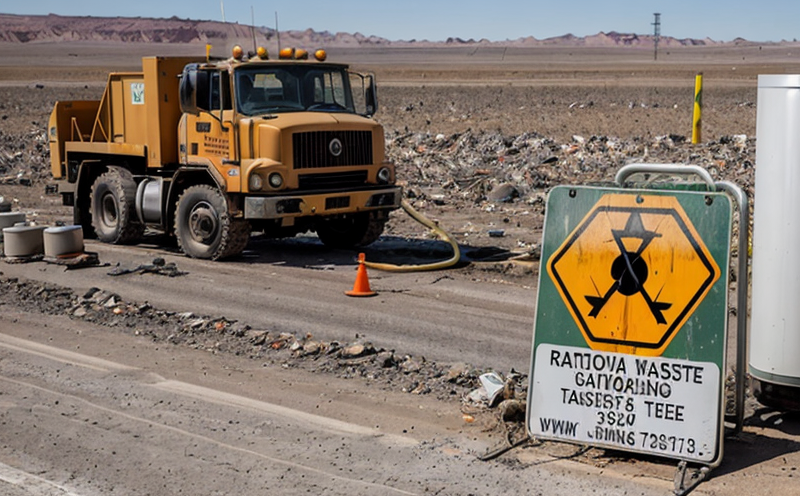ISO 2889 Airborne Radioactivity Monitoring in Waste Facilities
The ISO 2889 standard provides a framework for monitoring airborne radioactive particles in waste facilities to ensure compliance with international safety and environmental standards. This service is critical for organizations handling radioactive materials, particularly those involved in the management of nuclear fuel cycle wastes or decommissioning sites.
Understanding the impact of airborne radioactive emissions on both human health and the environment necessitates adherence to stringent monitoring protocols. ISO 2889 specifies procedures for sampling, analyzing, and reporting levels of alpha, beta, gamma, and neutron emissions. This standard ensures that facilities are capable of detecting even minute amounts of radioactivity in ambient air, thereby minimizing potential risks.
The service entails a comprehensive approach to airborne radioactivity monitoring. It includes the deployment of specialized sampling equipment, rigorous quality assurance protocols, and meticulous data analysis. Our team is equipped with state-of-the-art instrumentation, including high-efficiency samplers, Geiger counters, and gamma spectrometers, which are essential for accurate measurement.
Sampling locations within a waste facility are strategically chosen to capture representative air samples from various areas of concern. Specimen preparation involves the collection of particulates on specialized filters or collectors, followed by their transport to our laboratory for analysis. The analytical techniques employed adhere strictly to ISO 2889 guidelines, ensuring consistent and reliable results.
Our service also encompasses detailed reporting tailored to meet the requirements of regulatory bodies such as the International Atomic Energy Agency (IAEA), European Commission, and national authorities. Compliance reports are provided in a clear and concise manner, highlighting any detected emissions above specified thresholds. This information is crucial for facility operators to take corrective actions if necessary.
The importance of this service cannot be overstated. In sectors like nuclear power generation, spent fuel reprocessing, and decommissioning of nuclear facilities, even small quantities of radioactive materials can pose significant health risks. By adhering to ISO 2889 standards, we help our clients maintain a safe working environment while complying with stringent regulatory requirements.
Our team works closely with facility operators to ensure that all aspects of the monitoring process are conducted according to best practices. This includes regular calibration and maintenance of equipment, continuous training for personnel involved in sampling, and adherence to strict quality control measures throughout the entire process.
Why It Matters
The significance of airborne radioactivity monitoring cannot be overstated. In waste facilities, radioactive materials can escape into the atmosphere through various pathways, including leakage from storage containers or accidental releases during handling and transport.
- Health Risks: Exposure to high levels of radiation can lead to serious health issues, ranging from skin burns to increased risk of cancer. Monitoring ensures that these risks are minimized by identifying and addressing any potential leaks promptly.
- Environmental Impact: Radioactive substances in the air can settle on soil, water bodies, and vegetation, causing widespread contamination. Effective monitoring helps prevent such environmental degradation.
- Regulatory Compliance: Adherence to ISO 2889 is mandatory for many organizations involved in nuclear activities. Non-compliance can lead to severe penalties and reputational damage.
In summary, airborne radioactivity monitoring is a vital component of waste facility management, ensuring the safety of workers, the public, and the environment while maintaining regulatory compliance.
Applied Standards
The ISO 2889 standard provides specific guidelines for the sampling and analysis of airborne radioactive particles in waste facilities. The standard specifies the types of equipment to be used, the protocols for sample collection, preparation, and transport, as well as the analytical methods that must be employed.
Key aspects covered by ISO 2889 include:
- Sampling Techniques: The standard details various sampling techniques suitable for different types of radioactive materials, including beta-emitting radionuclides and alpha particles.
- Sample Preparation: Detailed procedures are provided for the preparation of samples on specialized filters or collectors to ensure accurate measurement.
- Analytical Methods: ISO 2889 outlines specific analytical methods, such as gamma spectrometry and alpha spectrometry, which must be used for quantifying radioactive emissions.
- Data Reporting: The standard specifies the format and content of reports to ensure that all relevant information is captured accurately.
By adhering strictly to these standards, we provide clients with reliable data that can be used to make informed decisions about operational practices and regulatory compliance.





